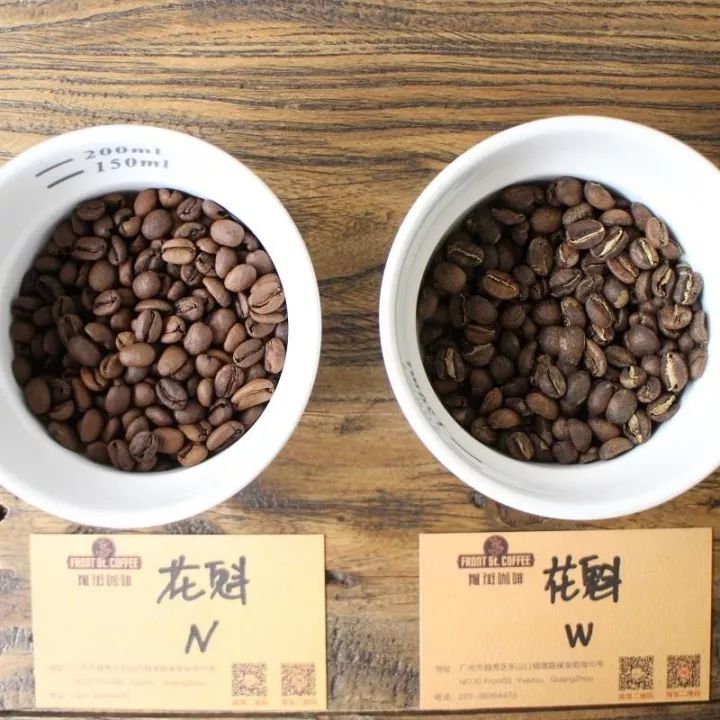Introduction to the flavor description method of Gucci Ethiopian G1 washing and sunbathing Sidamo coffee

The relationship between Sidama and Guji:
Sidamo region
Sidamo coffee is very diverse. Different soil types, microclimate and numerous native coffee species, high mountains, highlands, plateaus, valleys and plains, diverse terrain, and the geology of the area is rich in nutrients, well drained volcanic soil, soil depth of nearly two meters, the surface soil is dark brown or brown. Sidamo grows in the southernmost Ethiopian plateau at an altitude of 4,600 - 7,200 feet (Sidamo province). It is a famous boutique coffee area in southern Ethiopia, bordering Kenya, southeast of Gemma and due south of the capital. It is usually sweeter and more popular than most people. Its annual output is about 225000 bags/60kg. Sidamo coffee flavor is very diverse, with different soil types, microclimate and countless native coffee species. High mountains, highlands, plateaus, valleys and plains, diverse terrain, and the geology of the area is rich in nutrients, well drained volcanic soil, soil depth of nearly two meters, the surface soil is dark brown or brown. Its greatest advantage is that soil fertility is maintained through the recycling of organic matter, using withered leaves from surrounding trees or plant roots as fertilizer. Therefore, the coffee produced in the town has obvious differences and characteristics
From 2010 to 2012, it won high scores of CR92~94 from the authoritative coffee evaluation website in the United States. This shows that the production of raw beans extraordinary.
Guji production area introduction
Guji production area is located in the southeast of the famous production area Yejia Xuefei.
In the administrative division, it belongs to the Oromia Region→Guji Zone, which belongs to the regional coffee green beans. As Yejia Shefei became widely known after becoming famous, it became the Guji Zone, an independent sub-region of Sidamo. This batch was produced near the town of Dara Woreda in Sidama province. Shilcho Coop Coffee is produced by small farmers. Founded in 1976, it is currently a member of the Sidama Coffee Farmer Cooperative Union (SCFCU). SCFCU is Ethiopia's largest coffee cooperative union, currently with about 46 member cooperatives, making it the second largest coffee cooperative in Ethiopia.
The difference between washed and sun-dried sidamo coffee flavor:
After harvesting, coffee beans must be immediately processed, otherwise they will start to ferment and cause coffee beans to produce odors. There are two methods of treatment,"sun method" and "washing method", which will cause different flavors. The beans of solarization method have complete natural mellow flavor, gentle aroma and more colloid; washing method has good mellow flavor, high aroma and lively acidity.
[Sunlight Sidamo]: The bean body is smaller than Longberry, green with yellow, in the Sidamo sun drying field, coffee is placed in the hemp net rack, workers take turns in the sun exposure, manually stir coffee, Sunlight Sidamo is usually marked with G4 export mostly, washed Sidamo because the processing process is more perfect than the sun, so most of the G2 grade exports more.
[Washed Sidama]: Coffee green is slightly gray, some places are coarse and some places are fine, acidity is soft and strong, alcohol is appropriate, sweet and spicy, it is one of the courtyard coffee in the southern highlands of Ethiopia. It differs from African coffee in that Sidamo has a clear acidity, a smooth taste and a delicate floral aroma.
The difference between dry incense:
Sunlight Sidamo: light fermented bouquet, blueberry, grape bouquet
Washed Sidamo: Citrus, Jasmine
[Soak coffee in a cup at a ratio of 8 grams of powder to 150 ml of 94 ° C hot water for 3-4 minutes until coffee grounds form]
Difference in taste:
Sunlight Sidamo: Sunlight is a bit complicated, light fermented wine fragrance, caramel will be heavier, taste will be a lot richer, honey sweet, cocoa with a little spice, body thick and lasting.
Washing Sidamo: The acidity of washing treatment will be brighter, just like citric acid, taste more fragrant, citrus fragrance is more obvious, and the latter part has some Earl Grey tea feeling.
Same: both have fruit acid flavor, similar to lemon citrus fruit
[Manual data]
[Sunlight Sidamo]: It is recommended to use 15 grams of powder for one person at 89-90 ° C water temperature, small Fuji grinding degree 4, V60 filter cup, water powder ratio 1:15, first water injection 30g, stewing for 25s, second water injection 120 g water, second water injection to 225g water, no water at the end, extraction time about 2:05s;
[Washing Sidamo]: It is recommended to use 15 grams of powder for one person at 86-87 ° C water temperature, 3.5-4 grinding degree of small Fuji, 1:15 water powder ratio, V60 filter cup, 1:15 water powder ratio, 30g water injection for the first time, stewing for 25s, 120 g water injection for the second time, water injection for the second time to 225g water, no water for the tail section, extraction time of 2:10s;
Guji Coffee
Shakisso/Shakiso is located in the Guji region of Sidama and is one of the micro-regions with very regional characteristics in Sidama. The coffee in this region is quite unique, and the coffee produced has repeatedly received market attention. Ninety Plus 'legendary bean (nekisse) originally means Nectar from shakisso, and its production area and name are all from shakisso.
Ethiopian Sidama is a type of Arabica coffee of single origin, grown in Sidama province of Ethiopia. Like most African coffees, Ethiopian sidamo is characterized by small grey beans, but is characterized by its rich, spicy, alcoholic or chocolate-like flavor and floral aroma. The most distinctive flavors found in all Sidamo coffees are lemon and citrus, bright and crisp acidity. Sidamo coffee includes Yirgachefe and Guji coffee, both of which are of excellent quality.
Washing-type coffee flavor is less likely to have wild flavor, with pure, refreshing characteristics, suitable for City to Full City roasting degree; some excellent Ethiopian washing-type coffee beans, sometimes can be perceived as obvious lemon, citrus essential oils, jasmine flowers, honey flavor, etc., sour more obvious, mellow feeling thin. Sun-treated mocha beans have wild flavor in basic flavor, but the degree or more and less difference, more suitable for Full City to Vienna baking degree performance. Excellent sun, mocha beans, with a distinct chocolate finish, some with a pleasant blueberry-like fermented fruity and red-wine texture
According to the different processing methods of coffee beans, Yejia Xuefei is divided into two categories:
Class A is the washing treatment method, the grade standard is formulated by SCAA of "American Fine Coffee Association", which is divided into Gr-1;Gr-2, the smaller the Arabic numeral, the higher the grade, G1 Ye Jia Sherfie style is distinct, citrus flavor and floral flavor are integrated in the coffee liquid, which is delicious that everyone can not resist;
Class B is the sun treatment of coffee beans, grades are divided into, Gr-1;Gr-3;Gr-4;Gr-5, the same highest grade of G1 sun plus sherry fruity, open with freshly roasted G1 sun plus sherry coffee bag can subvert everyone's original understanding of coffee, only to taste the highest grade of sun plus sherry people will believe that coffee is a fruit..

Important Notice :
前街咖啡 FrontStreet Coffee has moved to new addredd:
FrontStreet Coffee Address: 315,Donghua East Road,GuangZhou
Tel:020 38364473
- Prev

Description of the flavor of sun-cured Sidamo coffee with moderate sweet and sour taste introduction to the characteristics of varieties
Producing area of China Coffee Network: blind test in the Sidamo producing area of southern Ethiopia: Ethiopian coffee is mainly in the sun, but now it seems to have changed in recent years, and the fine coffee movement has made people's mouths more and more picky. Less gossip, the aroma is obvious: according to Westerners, it is rose tea, but I think it is more like a lighter brown sugar and ginger soup, as well as honey.
- Next

Kenya Jinchu Coffee Flavor description treatment characteristics of Grinding degree introduction to the Manor
Product name: Kenya Jinchu AA TOP English: Kenya Gichugu Embu AA TOP production area: Jinchu Valley (Gichugu Division,Kirinyaga East District) producer: Enbu treatment Plant (Embu Washing Station) treatment: Kenyan double washing treatment altitude: 1550-1750 meters above sea level: SL28,SL34 harvest time: 2
Related
- Detailed explanation of Jadeite planting Land in Panamanian Jadeite Manor introduction to the grading system of Jadeite competitive bidding, Red bid, Green bid and Rose Summer
- Story of Coffee planting in Brenka region of Costa Rica Stonehenge Manor anaerobic heavy honey treatment of flavor mouth
- What's on the barrel of Blue Mountain Coffee beans?
- Can American coffee also pull flowers? How to use hot American style to pull out a good-looking pattern?
- Can you make a cold extract with coffee beans? What is the right proportion for cold-extracted coffee formula?
- Indonesian PWN Gold Mandrine Coffee Origin Features Flavor How to Chong? Mandolin coffee is American.
- A brief introduction to the flavor characteristics of Brazilian yellow bourbon coffee beans
- What is the effect of different water quality on the flavor of cold-extracted coffee? What kind of water is best for brewing coffee?
- Why do you think of Rose Summer whenever you mention Panamanian coffee?
- Introduction to the characteristics of authentic blue mountain coffee bean producing areas? What is the CIB Coffee Authority in Jamaica?

